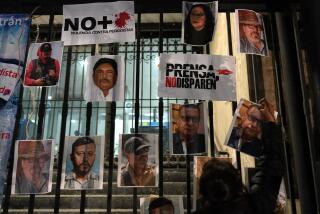FBI Files Shed Little Light on Ruben Salazar’s Death
- Share via
More than 200 pages of documents released by the FBI this week reveal that agents investigated award-winning Times journalist Ruben Salazar on several occasions as he reported on Cuba during the Cold War, but the records shed no new light on the questionable circumstances of the newsman’s 1970 slaying by a Los Angeles sheriff’s deputy.
The FBI also was concerned about unrest in the days after Salazar was killed while covering a massive anti-Vietnam War rally in East Los Angeles and monitored political and community meetings where actions were planned to protest the reporter’s killing, the records show.
The Salazar documents, which include previously classified material, were released Tuesday in response to a Freedom of Information Act request filed by The Times more than five years ago. Twelve pages out of 277 that the FBI says it has on Salazar were withheld. Some portions of the released records were blacked out, often for what officials cited as national security reasons.
Still, the records offer a glimpse into the FBI’s preoccupation with Communism and Cuban leader Fidel Castro, as well as FBI surveillance efforts of what it considered to be radical activities by Chicano political and activist groups.
A Times columnist and KMEX-TV news director at the time of his death, Salazar was killed instantly by a sheriff’s tear gas projectile while he sat in an East Los Angeles bar. The newsman was taking a break from covering the National Chicano Moratorium rally against the Vietnam War, which had exploded into a riot along Whittier Boulevard.
Salazar was the most prominent Mexican American journalist of his time and has become an icon in the Latino community. From New York to Los Angeles, parks, schools and scholarships have been named in his honor.
All available evidence shows that Salazar’s killing was a tragic mistake. Sheriff’s officials have said that the deputy was operating under emergency conditions when he fired the wall-piercing tear gas missile through the curtained doorway of the Silver Dollar cafe. Sheriff’s officials later said that they had received reports of a man with a gun inside the bar.
A coroner’s inquest found that Salazar “died at the hands of another,” but the deputy was never charged with a crime. However, Los Angeles County did pay $700,000 to Salazar’s family to settle a lawsuit.
To this day, many activists and some of Salazar’s friends believe that the newsman was killed because of his hard-hitting columns and TV coverage regarding police relations with the Mexican American community.
“I definitely felt the word was out among the cops to get Ruben one way or another,” said Charlie Ericksen, publisher of Hispanic Link news service in Washington. Ericksen was a friend of Salazar at the time and set up a meeting in which the newsman told friends that police were after him.
Raul Ruiz, now a Chicano studies professor at Cal State Northridge, took photographs as deputies swooped down on the bar. “Why out of all those thousands of people, would Ruben be killed under very peculiar circumstances,” Ruiz said. “To me that seems too coincidental.”
Given the political context of the era, it is not surprising that the FBI had a file on Salazar, historians and others say. Under former Director J. Edgar Hoover, the agency investigated or kept tabs on scores of journalists, activists, celebrities and others involved in the turbulent events of the period.
“This is not anything out of the ordinary,” said UC Berkeley Chicano studies professor Carlos Munoz Jr., a former Eastside student activist who was the subject of FBI surveillance efforts.
The FBI investigated Salazar at least three times between 1967 and 1968, while he was Mexico City bureau chief for The Times. Two of the investigations were prompted when Salazar visited Cuba for the newspaper.
In both instances, the FBI did a background check on Salazar’s family history or made calls to The Times to confirm that he was a reporter. The FBI also monitored what Salazar did while he was in Cuba and reported his activities to bureau headquarters in Washington .
A September 1967 memo, for instance, said that Salazar had visited Cuba a month earlier to cover a conference organized by supposedly radical Latin American political activists. The conference goals, the memo warned, were “the promotion of guerrilla warfare and revolution in Latin America [and] support of the Negro ‘revolution’ in the United States.”
On another occasion, in January 1968, the FBI launched an investigation after a blue 1965 Chevrolet sedan was spotted “in the vicinity” of the Cuban Embassy.
Two months later, after researching records with the California Department of Motor Vehicles, the FBI determined that the car belonged to Salazar.
“Since no specific leads regarding Salazar are outstanding,” a March 1968 memo said, “it is recommended that this case be closed.”
By early 1969, Salazar was back in Los Angeles to cover Mexican American affairs during a tumultuous time on the Eastside. Activists had begun calling themselves Chicanos, and thousands of students had staged walkouts demanding better schools and more Chicano teachers.
The movement reached its height on Aug. 29, 1970, when 20,000 to 30,000 people from across the nation participated in the Chicano antiwar protest. Later that day, Salazar was killed.
The FBI documents show that after Salazar’s death, FBI informers or agents monitored meetings in Los Angeles, Oakland, Santa Barbara and El Paso. In some cases, the meetings were called specifically to protest Salazar’s killing, while in others he was one of several topics discussed.
More to Read
Sign up for Essential California
The most important California stories and recommendations in your inbox every morning.
You may occasionally receive promotional content from the Los Angeles Times.











